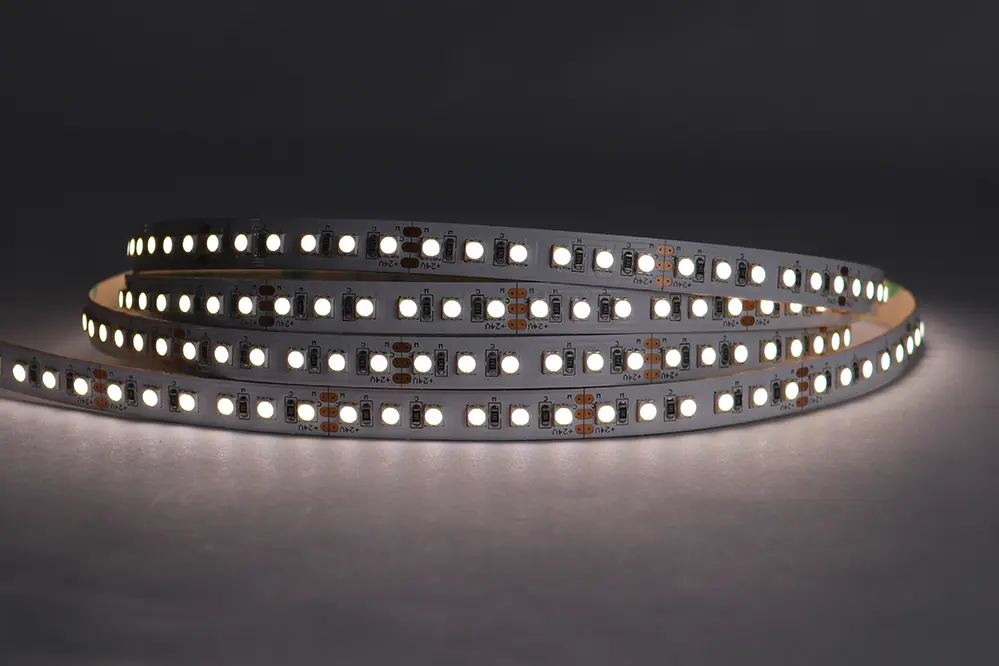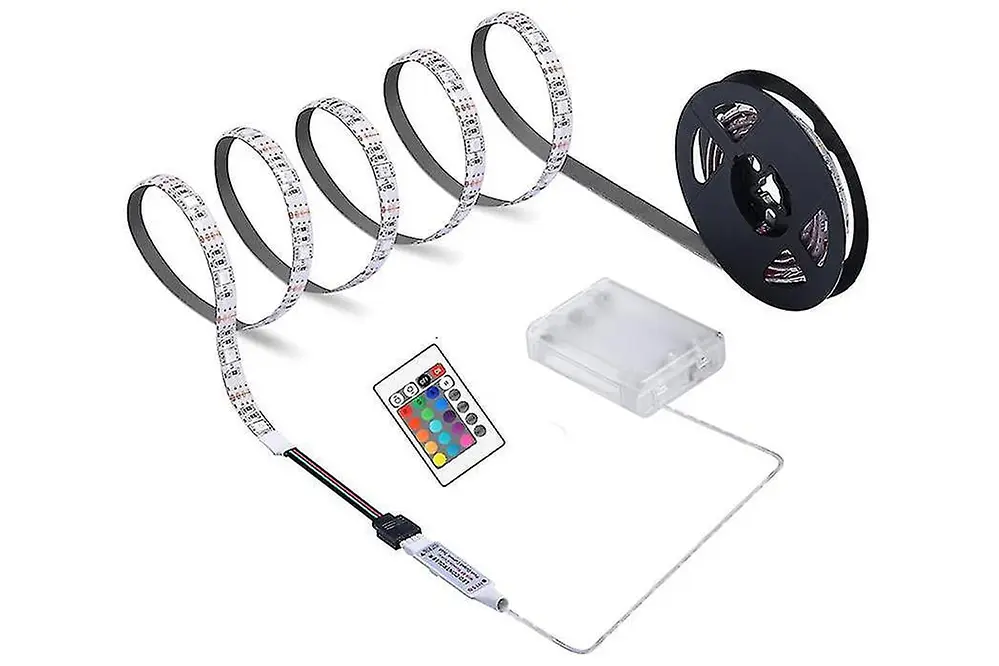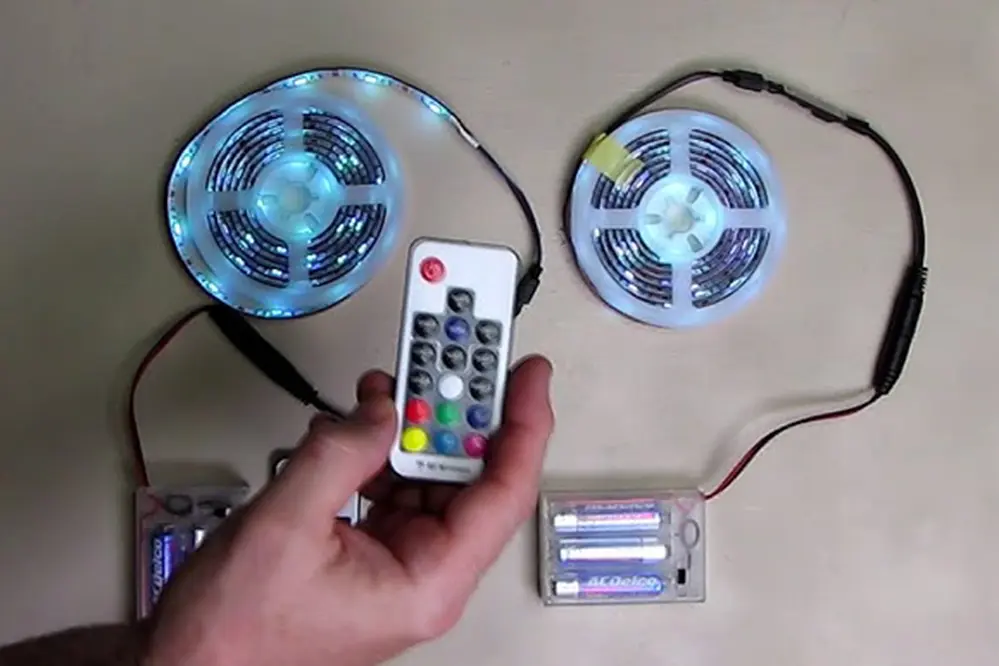How long do battery-powered LED strips last when you’re trying to set the perfect mood for a dinner party or a cozy night in? Many people face the challenge of ensuring their lighting lasts throughout the evening without needing constant battery changes.
Addressing this issue is essential for anyone who relies on LED strips for ambiance or practical lighting. Knowing how long they last can help you plan better and avoid any unexpected darkness.
There are various solutions and insights available to extend the life of your LED strips, from choosing the right batteries to adjusting brightness settings. Each approach offers unique benefits that can enhance your lighting experience.
Stay tuned as we explore these strategies in detail, providing you with the knowledge to make informed decisions about your lighting needs.
Factors Affecting Battery Life

When pondering the question “how long do battery LED strips last,” several pivotal factors influence their operational lifespan. These variables determine how effectively the LED strips perform and how often you need to replace the batteries.
One critical variable is the quality of the LED strip itself. Higher-quality strips utilize less power.
Moreover, factors such as the brightness and settings, including color (offering different light intensity levels), are significant. They require varying amounts of energy.
Frequent usage times or patterns substantially impact the longevity of battery life. Consistent usage depletes batteries faster.
External conditions such as temperature also noticeably affect battery performance, since cold environments may reduce the charge retention of many standard batteries, inhibiting optimal strip performance.
Ultimately, optimizing these conditions ensures one’s LED strip’s vibrancy endures, stretching their utility to its maximum capacity. Each component, from the strip’s design to the environmental context, plays an essential role.
Types of Batteries Used
Battery-powered LED strips commonly use alkaline, lithium, and rechargeable batteries, each contributing distinct advantages and lifespan to your setup.
Alkaline batteries, the most traditional choice, provide a convenient and cost-effective power source. However, their energy capacity can be limiting for prolonged use. Lithium batteries, favored for their longer lifespan and ability to operate efficiently in colder environments, are excellent for those seeking reliable performance. Rechargeable batteries, though initially more expensive, offer sustainability and long-term savings by allowing multiple recharges without performance loss.
Selecting the right battery type can greatly affect how long your LED strips last. As you assess your power needs, consider not only the initial cost but also the longevity and efficiency each battery type offers. The optimal choice will depend on your specific usage scenario and desired strip brightness.
Ultimately, understanding the differences among battery types empowers you to make informed decisions about maximizing your led strip lights’ operational life, ensuring that they shine brightly and consistently. By considering the nuances of each battery type, users can confidently illuminate their spaces with grace and efficiency, while also being mindful of cost-effectiveness and sustainability.
LED Strip Power Consumption
The quest for efficient lighting begins with understanding LED strip power consumption, a key factor in ensuring optimal performance and longevity.
Delving into these intricacies, LED strip power consumption is a fascinating balance between energy usage and output efficiency, providing dazzling illuminations while maintaining energy efficiency that is unparalleled. This delicate dance has consequently spawned innovative designs and technologies, that align perfectly with users’ quest for energy-efficient lighting solutions.
Typically, LED strips consume minimal power, leading our charge toward a sustainable future. In comparison to traditional lighting, their low power consumption heralds a more cost-effective alternative while reducing environmental impact.
Notably, the power consumption of LED strips, measured in watts, varies across different models and usage patterns, making it essential for users to comprehend these factors. For instance, factors like strip length and brightness intensity will each play defining roles. Equipped with this informed knowledge, users can decisively strategize the use of LED strips to suit their unique needs, exploring a world lit by innovation and sustainability.
Comparing LED Strip Models

When it comes to LED strip models, understanding the differences is key to choosing the right option for your needs.
Primarily, LED strip models can be distinguished by a variety of factors, including voltage requirements, color variations, flexibility, and adhesive strength. Battery-powered LED strips, in particular, offer the convenience of mobility and ease of installation, making them ideal for dynamic or limited-access areas, and when combined with led strip lights, create versatile solutions for various lighting needs. Such versatility showcases the potential for artistic lighting installations, personalizing your environment with creativity.
Moreover, battery LED strips come in a spectrum of brightness levels and operational settings. As technological advancements continue, many models feature energy-efficient functions, ensuring extended usage while preserving battery life. By evaluating these aspects, users can make informed choices about which LED strip model aligns best with their specific applications.
Ultimately, considering functional elegance and technological sophistication, selecting the appropriate LED strip model that incorporates advanced features can revolutionize your space. Whether you are enlivening a home, office, or outdoor setting, these innovative lighting solutions usher in a radiant future, illuminating paths and inspiring visions with every luminescent glow.
Average Lifespan of Battery-Powered LED Strips

Battery-powered LED strip lights present a remarkable feasibility, with the potential to transform spaces and moods through radiant illumination.
On average, the expected operational lifespan of a well-crafted battery-powered LED strip can extend significantly, reaching up to 25,000 to 50,000 hours, depending on usage conditions. Despite occasional misconceptions, these stellar lighting solutions offer robust longevity, showcasing energy-efficient technology that enhances their endurance without sacrificing performance quality.
Typically, users can expect up to several weeks of regular usage on a single set of batteries. By adjusting brightness settings and utilizing energy-saving modes, these led strip lights can prolong battery life, delivering consistent lighting brilliance over an extended period.
Consequently, by judiciously selecting led strip lights with superior design and energy-efficient functionalities, users can maximize the lighting experience and revel in the lasting glow they emit. This promising advancement in lighting technology not only paves the way for sustainable illumination but also promises to brighten environments with enduring access and unflinching innovation.
How Long Do Battery Led Strips Last with Alkaline Batteries?
Battery LED strip lights offer versatile lighting solutions efficiently.
When powered by alkaline batteries, these LED strips can exhibit outstanding longevity. The factor predominantly influencing battery life is the capacity of these batteries, which in turn is determined by their milliamp-hour (mAh) rating. Consequently, devices referred to as being on the forefront of innovative lighting can experience utilization hours spanning from 10 to 20 hours depending on brightness settings.
Low brightness extends LED strip lifespan.
In general, usage duration of these strips can provide more than a mere day of brilliance or weeks of intermittent lighting—based on how they’re employed—which holds supreme relevance in energy-conscious scenarios.
Ultimately, users who embrace inventive practices for LED strip usage are rewarded with immersive lighting experiences, illuminating their spaces way beyond mere functional lighting. With anticipated advancements in battery technology post-2023, this LED lighting domain is poised for an exciting future, promising increasingly prolonged and efficient luminous encounters that blend brightness with sustainability.
Impact of Usage Frequency
Longer usage impacts LED strip longevity.
The frequency with which battery-powered LED strips are used plays a pivotal role in determining their lifespan. For those who rely on these vibrant strands as everyday illuminators, it becomes essential to acknowledge that extended periods of illumination inevitably drain battery resources. Therefore, understanding how often and for what duration the LED strips are utilized holds significance in predicting overall use longevity.
Infrequent use expands battery LED strip lifespan.
Particularly, those who opt for occasional use or short bursts of brilliance may witness their battery-powered LED strips performing efficiently for longer periods. This strategic approach not only maximizes the return on investment but also aligns with sustainable lighting practices.
Thus, the frequency of usage stands as a potentially powerful variable that endows users with the ability to control and enhance the utility of these luminous assets. Those who master the art of moderated usage can ensure their LEDs last longer, promoting energy preservation and optimizing engagement with this dynamic technology.
Influence of Brightness Settings
In the realm of battery-powered LED strips, brightness settings wield a significant influence on longevity. Using dimmers, a valuable feature of many modern LED strips, can substantially extend their lifespan.
Bright settings rapidly deplete the battery life of LED strips, making lower brightness settings preferable as they use fewer watts. Consequently, a strategic adjustment of the strip’s brightness can foster extended durability.
By utilizing the LED strip at a reduced brightness level, power consumption decreases, leading to less frequent battery replacements or recharges. Furthermore, this practice contributes to a nuanced balance between illumination needs and energy conservation.
Users who explore various brightness settings might discover that their needs are adequately met without resorting to maximum brightness. Therefore, it is a prudent enhancement in the utility spectrum of LED strips.
Ultimately, the key to unlocking these advantages lies in the conscientious evaluation of how brightness adjustments can optimize LED strip usage. Maintaining an optimal brightness level supports prolonged use and aligns with an eco-friendly approach to lighting innovation.
Tips for Extending Battery Life
Maximizing battery life is a savvy endeavor.
Prioritize strategic usage by considering the time-of-day when utilizing your LED strips. This small shift in routine can make a significant difference in preserving energy, such as using natural light during the day and saving LED use for the darker hours. Consequently, reduced usage translates into prolonged battery longevity.
Employ rechargeable batteries for extended economics.
Such batteries can significantly cut down on waste – as well as hassle – and provide consistent energy outputs for your LED strips. Rechargeable options promise long-term sustainability and economic benefits.
Efficiency in setting usage schedules, coupled with recent technological advancements in battery sciences, can achieve a harmonious coexistence between cutting-edge luminance and eco-conscious living. These mindful adjustments today pave the way for a brighter, more sustainable tomorrow.
Seasonal vs. Continuous Use
The lifespan and functionality of battery-powered LED strips vary significantly, depending on whether they are used seasonally or continuously. This consideration directly affects how long the battery LED strips last.
Seasonal usage usually means turning on the lights for special occasions. This method consumes less energy overall.
Conversely, continuous usage involves keeping the lights on most of the time, possibly daily. This accelerates battery depletion.
For those who opt for continuous usage, investing in rechargeable batteries becomes essential to maintain consistent illumination. However, even with this choice, some energy-saving measures can maximize battery longevity.
Seasonal use typically results in batteries lasting longer, as lights are activated only occasionally. Users can capitalize on this by strategically planning when LEDs are truly needed, thus extending usage time and battery life concurrently.
Overall, the key is to balance what’s best for your lighting needs. Whether seasonal or continuous, making thoughtful decisions helps maintain the benefits battery-powered LEDs and led strip lights bring.
Charging and Maintenance Tips
When it comes to ensuring the longevity and efficiency of your battery-powered LED strip lights, attention to charging and maintenance cannot be overlooked.
To maximize battery life, adopting a regular charging schedule can make a significant difference. Avoid letting the batteries drain completely; instead, charge them when they’re low but not fully depleted. This practice of partial charging can enhance overall battery lifespan, preventing premature degradation and maintaining optimal performance.
Furthermore, store your batteries in a cool, dry place to prevent damage. If unused for extended periods, recharge them occasionally to maintain their vitality, as a dormant battery can lose capacity over time.
Lastly, invest time in inspecting your LED strips for any signs of wear or damage, particularly on the connectors and contacts. Keeping these areas clean and free from dust ensures uninterrupted power flow and efficient operation. By incorporating these proactive maintenance steps, you will not only prolong the life of your LED strips but also foster sustainable energy use, reinforcing your commitment to both innovation and efficiency.
Signs of Battery Degradation
Battery degradation can manifest subtly, signaling that your efficiency-focused strategy must adapt to evolving needs and promising continued illumination.
Firstly, one noticeable symptom of a degrading battery is a gradual reduction in the brightness of the LED strips, which can occur even when the battery has been fully charged. This dimming effect is a clear indication that the battery’s ability to hold a charge is waning—a call to action for prompt attention to avoid unwanted darkness interrupting your creative or practical endeavors.
Moreover, batteries encountering degradation may exhibit a shorter operating duration, struggling to power LED strips for the same length of time as before on a full charge. This behavior is an early-warning system, suggesting the need for strategic reevaluation and potential replacement to ensure continuous functionality and uphold the brilliance that LED strips promise.
Finally, in advanced stages, physical signs such as swelling or leakage may become apparent, which is not just a sign of diminishing performance but also poses potential safety risks. This profound transformation underscores the critical importance of vigilance in maintenance and timely intervention, ensuring that your LED strips continue to imbue your spaces with the vibrancy and vitality you envision. By understanding these signs, you empower yourself to navigate and triumph over these challenges, sustaining a bright and beautiful environment.
Eco-Friendly Alternatives
Explore eco-conscious lighting solutions.
Transitioning to eco-friendly LED alternatives can profoundly impact the environment. Not only do they use less energy, but they also minimize the carbon footprint of your home, contributing to a sustainable future. Moreover, investing in such options extends the lifespan of light installations, easing the strain on natural resources.
Consider solar-powered LED strips.
They harness the sun’s energy to illuminate your space—offering renewable brilliance without the reliance on grid electricity. This makes them an exceptional choice for those with an eco-oriented vision.
In addition to solar options, advances in rechargeable battery technology continue to revolutionize energy storage, supporting LED strips’ functionality with minimal waste. By integrating the latest eco-friendly innovations into your lighting strategy, you not only enhance the aesthetics of your home but also champion environmental sustainability. These strides forward empower homeowners to participate in the global movement toward a greener planet, demonstrating how thoughtful choices can illuminate a path to a brighter, more sustainable future.
When to Replace Battery-Powered LED Strips
Recognizing when to replace your battery-powered LED strips is essential for maintaining optimal lighting performance. With time, the efficiency of the light output can begin to diminish.
Recent years, studies indicated a steady decline in the lumens produced by LED strips as they age and experience regular use. It’s not merely about the lights themselves, but the overall degradation of the batteries driving them.
To ensure that your lighting remains as vibrant as when first installed, monitor the lifespan of both the light strips and the accompanying batteries. Watching for signs such as frequent flickering or reduced brightness can help.
Generally, the lifespan of LED strips is quite impressive, often spanning up to 50,000 hours, while batteries typically last for 3,000 to 5,000 hours. By actively observing these indicators, you can preempt unnecessary disruptions.
Proactively addressing these concerns maintains lighting quality and maximizes the efficacy of your energy-saving initiatives.
Conclusion
Battery-powered LED strips prove remarkably durable.
Their impressive lifespan, coupled with the potential for innovation, paints a bright future for this technology. As users practice diligent care and strategic battery replacement, they can enjoy prolonged periods of vivid lighting. Increasingly, these efficient and adaptable solutions underscore the importance of modern advancements.
Combine regular maintenance with periodic checks.
Such efforts ensure sustained performance, paving the way for uninterrupted illumination in various settings. Make it an exercise in proactive care – allocate time to assess battery integrity and light output, and you’ll find your environment consistently vibrant and efficient.
In summary, battery-powered LED strips bring both functionality and longevity, promising numerous opportunities for creativity and inspiration from 2024 and beyond. Whether in a cozy home setting or a dynamic commercial space, make your lighting solutions part of a larger commitment to sustainability and forward-thinking energy use.





